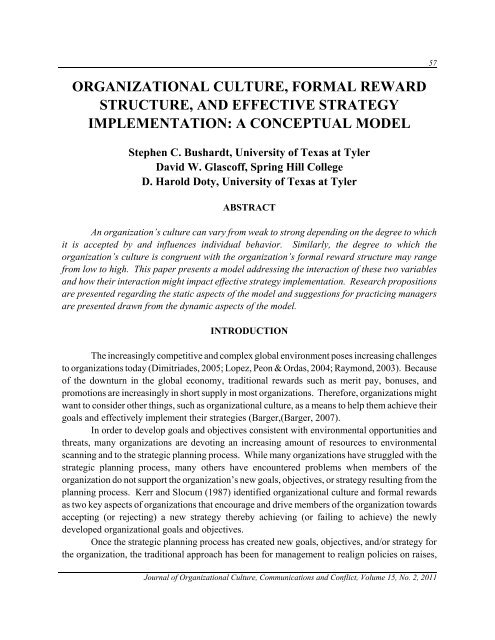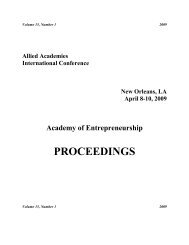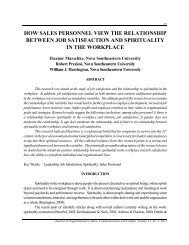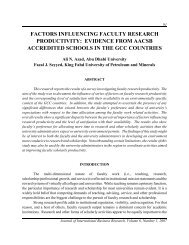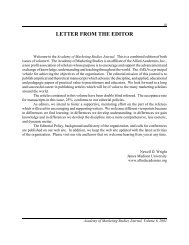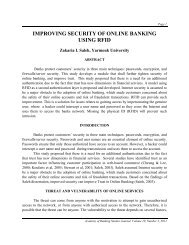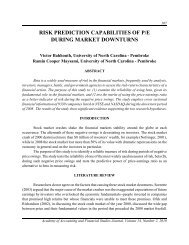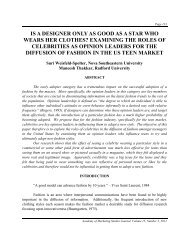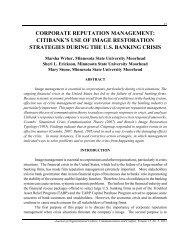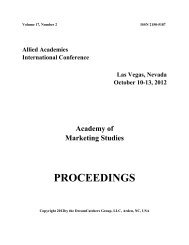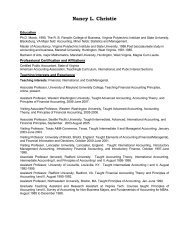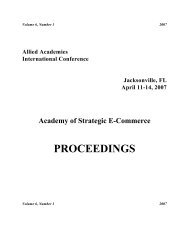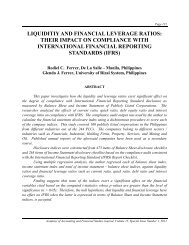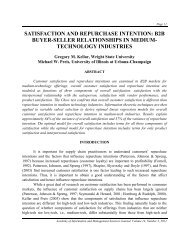ORGANIZATIONAL CULTURE, FORMAL REWARD STRUCTURE ...
ORGANIZATIONAL CULTURE, FORMAL REWARD STRUCTURE ...
ORGANIZATIONAL CULTURE, FORMAL REWARD STRUCTURE ...
Create successful ePaper yourself
Turn your PDF publications into a flip-book with our unique Google optimized e-Paper software.
57<br />
<strong>ORGANIZATIONAL</strong> <strong>CULTURE</strong>, <strong>FORMAL</strong> <strong>REWARD</strong><br />
<strong>STRUCTURE</strong>, AND EFFECTIVE STRATEGY<br />
IMPLEMENTATION: A CONCEPTUAL MODEL<br />
Stephen C. Bushardt, University of Texas at Tyler<br />
David W. Glascoff, Spring Hill College<br />
D. Harold Doty, University of Texas at Tyler<br />
ABSTRACT<br />
An organization’s culture can vary from weak to strong depending on the degree to which<br />
it is accepted by and influences individual behavior. Similarly, the degree to which the<br />
organization’s culture is congruent with the organization’s formal reward structure may range<br />
from low to high. This paper presents a model addressing the interaction of these two variables<br />
and how their interaction might impact effective strategy implementation. Research propositions<br />
are presented regarding the static aspects of the model and suggestions for practicing managers<br />
are presented drawn from the dynamic aspects of the model.<br />
INTRODUCTION<br />
The increasingly competitive and complex global environment poses increasing challenges<br />
to organizations today (Dimitriades, 2005; Lopez, Peon & Ordas, 2004; Raymond, 2003). Because<br />
of the downturn in the global economy, traditional rewards such as merit pay, bonuses, and<br />
promotions are increasingly in short supply in most organizations. Therefore, organizations might<br />
want to consider other things, such as organizational culture, as a means to help them achieve their<br />
goals and effectively implement their strategies (Barger,(Barger, 2007).<br />
In order to develop goals and objectives consistent with environmental opportunities and<br />
threats, many organizations are devoting an increasing amount of resources to environmental<br />
scanning and to the strategic planning process. While many organizations have struggled with the<br />
strategic planning process, many others have encountered problems when members of the<br />
organization do not support the organization’s new goals, objectives, or strategy resulting from the<br />
planning process. Kerr and Slocum (1987) identified organizational culture and formal rewards<br />
as two key aspects of organizations that encourage and drive members of the organization towards<br />
accepting (or rejecting) a new strategy thereby achieving (or failing to achieve) the newly<br />
developed organizational goals and objectives.<br />
Once the strategic planning process has created new goals, objectives, and/or strategy for<br />
the organization, the traditional approach has been for management to realign policies on raises,<br />
Journal of Organizational Culture, Communications and Conflict, Volume 15, No. 2, 2011
The body of this manuscript is not reproduced in this posting. The full text of the manuscript is<br />
available through most university libraries. Should you have difficulty in finding the full text,<br />
you may acquire it from the original journal. Visit http://www.alliedacademies.org to find a link<br />
to the original journal source.
contingent on the level of environmental threat, it is often difficult to separate out the impact of the<br />
leader’s personality as a driving force.<br />
IMPLICATIONS FOR PRACTICING MANAGERS<br />
Managers must devote considerable time and resources to assess environmental<br />
opportunities and threats and to develop organizational goals and objectives consistent with<br />
environmental constraints. However, having done so may be insufficient to ensure the successful<br />
implementation of an organization’s strategy without the commitment and efforts of its members.<br />
Managements’ attempts to realign the formal reward structure with organizational goals and<br />
objectives solely through the human resource function have often failed to energize employees<br />
towards the new goals and objectives. The limited success of realigning the reward structure<br />
reflects an inability to manage individual behavior due to rewards not being administered in a<br />
timely manner, failure to use a variable ratio reinforcement schedule, and the lack of time most<br />
managers face in the challenging jobs of today. Managers would be more effective if they focused<br />
on using formal rewards as means to manage the culture instead of as a means to manage the<br />
individual. Schein (1992) suggests, “[t]he only thing of real importance that leaders do is to create<br />
and manage culture” (p. 5).<br />
Practicing managers need to assess the organizational culture as a part of the strategic<br />
planning process. When goals and objectives change, managers need to implement a systematic,<br />
goal-directed process for shifting the culture. The issue involves whether to gradually change the<br />
culture or to take a revolutionary approach. As practicing managers begin the change process, they<br />
need to identify not only the desired new sets of rule-governed behaviors for building but also the<br />
undesired behaviors for weakening or destruction.<br />
The primary job of a manager is to manage the culture not the individual. Organizational<br />
leadership can manage the culture through the ceremonies, storytellers, heroes, rituals and<br />
gatekeepers that it encourages or discourages by changing activities and by changing incumbents<br />
in key positions. The model presented here illustrates the challenges leaders face – to destroy the<br />
current culture, to strengthen the culture already present, or to create a new culture aligned with the<br />
strategic objectives. An important decision in the change process is the speed by which cultural<br />
change is implemented which is, in part, contingent on the personality of the leader and the degree<br />
of outside threat. The practicing manager’s job is difficult and challenging, requiring constant and<br />
continuous adjustment to ensure cultural alignment with organizational goals.<br />
REFERENCES<br />
67<br />
Amason, A.C., W.A. Hochwarter, K.R. Thompson & A.W. Harrison (1995). Conflict: an important dimension in<br />
successful management teams. Organizational Dynamics, 24(2), 20-35.<br />
Journal of Organizational Culture, Communications and Conflict, Volume 15, No. 2, 2011
68<br />
Arvey, R.D. & J.M. Ivancevich (1980). Punishment in organizations: A review, propositions, and research suggestions.<br />
Academy of Management Review, 5(1), 123-132.<br />
Asree, S., M. Zain & M.R. Razalli (2010). Influence of leadership competency and organizational culture on<br />
responsiveness and performance of firms. International Journal of Contemporary Hospitality Management,<br />
22(4), 500-516.<br />
Austin, N.A. & T.J. Peters (1985). A passion for excellence: The leadership difference. New York: Random House,<br />
Inc.<br />
Barger, B.B. (2007). Culture an overused term and international joint ventures: A review of the literature and a case<br />
study. Journal of Organizational Culture, Communication and Conflict, 11(2) 1-14.<br />
Benhalm, P. (1999). Challenges and trends in HR/IR programs: Bridging the gap for global competitiveness. S.A.M.<br />
Advanced Management Journal, 64(3), 9-14.<br />
Berg, P.O. (1985). Organizational change as a symbolic transformation process. In P.J. Frost, L.F. Moore, M.R. Louis,<br />
C.C. Lundberg & J. Martin (Eds.), Organizational culture (pp. 281-300). New York: Sage.<br />
Bushardt, S.C. & A. Fowler (1982). Compensation and benefits: Today’s dilemma in motivation. The Personnel<br />
Administrator, 27(4), 23-26.<br />
Bushardt, S.C. & A. Fowler (1987). Improving teaching effectiveness: Merit pay vs. organizational culture. Capstone<br />
Journal of Education, 7(2), 28-38.<br />
Bushardt, S.C., A. Fowler & S. Debnath (1988). Sales force motivation: A theoretical analysis. Human Relations,<br />
41(12), 901-914.<br />
Bushardt, S.C., J. Lambert & D.L. Duhon (2007). Selecting a better carrot: Organizational learning, formal rewards<br />
and culture: A behavioral perspective. Journal of Organizational Culture, Communication and Conflict, 11(2),<br />
67-79.<br />
Byrne, J.A. (1999). Chainsaw: The notorious career of Al Dunlap in the era of profit-at-any-price. New York: Harper<br />
Collins, Publisher, Inc.<br />
Cummings, L.L. (1984). Compensation, culture, and motivation: A systems perspective. Organizational Dynamics,<br />
12, 33-44.<br />
Deal, T.E. & A.A. Kennedy (1982). Corporate cultures: The rites and rituals of corporate life. Reading, MA:<br />
Addison-Wesley Publishing Co.<br />
Dimitriades, Z.S. (2005). Creating strategic capabilities: Organizational learning and knowledge management in the<br />
new economy. European Business Review, 7(4), 314-324.<br />
Ferster, C.B. & B.F. Skinner (1957). Schedules of reinforcement. Englewood Cliffs, NJ: Prentice-Hall, Inc.<br />
Journal of Organizational Culture, Communications and Conflict, Volume 15, No. 2, 2011
Fowler, A., S.C. Bushardt & A. Jones (1993). An evaluation of nurses’ job conflict resolution strategy and its<br />
implications for health care administrators. Health Progress, 74(5), 25-29.<br />
Gagliardi, P. (1986). The creation and change of organizational culture. Organizational Studies, 7, 117-134.<br />
Greiner, L. (1998). Evolution and revolution as organizations grow. Harvard Business Review, 76(3), 55-68.<br />
Hayes, S.C. (1987). A contextual approach to therapeutic change. In N.S. Jacobsen (Ed.), Psychotherapists in clinical<br />
practice (pp. 327-387). New York: The Guilford Press.<br />
Hayes, S.C., A.J. Brownstein, R.D. Zettle, I. Rosenfarb & Z. Korn (1986). Rule-governed behavior and sensitivity to<br />
changing consequences of responding. Journal of the Experimental Analysis of Behavior, 45(3), 237-256.<br />
Holbeche, L. (2009). Aligning human resources and business strategy. Amsterdam/London: Butterworth-Heinemann.<br />
Jones, M.A., S.C. Bushardt & G. Cadenhead (1990). A paradigm for effective resolution of interpersonal conflict.<br />
Nursing Management, 21(2), 64B-64L.<br />
Katz, D. & R.L. Kahn (1976). Systems rewards and individual rewards. In H.L. Tosi & W.C. Hamner (Eds.),<br />
Organizational behavior and management: A contingency approach. Chicago: St. Clair Press.<br />
Kerr, S. (1975). On the folly of rewarding A, while hoping for B. Academy of Management Journal, 18(4), 769-83.<br />
Kerr, J. & J.W. Slocum, Jr. (1987). Managing corporate culture through reward systems. Academy of Management<br />
Executive, 1(2), 99-108.<br />
Lopez, S.P., M.M. Peon & C.J.V. Ordas (2004). Managing knowledge: The link between culture and organizational<br />
learning. Journal of Knowledge Management, 8(6), 93-104.<br />
Lorsch, J.W. (1985). Strategic myopia: Culture as an invisible barrier to change. In R.H. Kilmann, M.J. Saxton & R.<br />
Serpa (Eds.), Gaining control of the corporate culture (pp. 84-102). San Francisco: Jossey-Bass Publishers.<br />
Lowe, C.F., A. Beasty & R.P. Bentall (1983). The role of verbal behavior in human learning: Infant performances on<br />
fixed-interval schedules. Journal of the Experimental Analysis of Behavior, 39(1), 157-164.<br />
McKenna, S.D. (1992). A cultural instrument: Driving organizational learning. Leadership and Organization<br />
Development Journal, 13(6), 24-29.<br />
McLauren, J. R. (2008). Leader effectiveness across cultural boundaries: An organizational culture perspective. Journal<br />
of Organizational Culture, Communication and Conflict, 12(1), 49-69.<br />
Paunova, M. (2007). How to characterize and evaluate the organizational culture. Economic Alternatives, 83, 111-121.<br />
Peters, T.J. & R.H. Waterman, Jr. (1982). In search of excellence: Lessons from America’s best-run companies. New<br />
York: Harper and Row, Publishers.<br />
69<br />
Journal of Organizational Culture, Communications and Conflict, Volume 15, No. 2, 2011
70<br />
Pisapia, J.R. (2009). The strategic leader: New tactics for a globalizing world. Charlotte, NC: Information Age<br />
Publishing.<br />
Ravasi, D. & M. Schultz (2006). Responding to organizational identity threats: Exploring the role of organizational<br />
culture. Academy of Management Journal, 49(3), 433-458.<br />
Raymond, L. (2003). Globalization, the knowledge economy, and competitiveness: A business intelligence framework<br />
for the development SMES. Journal of American Academy of Business, 3(1/2), 260-269.<br />
Reppucci, N. & T.T. Saunders (1974). Social psychology of behavior modification: Problems of implementation in<br />
natural settings. American Psychologist, 29, 649-660.<br />
Sackmann, S.A. (1991). Cultural knowledge in organizations: Exploring the collective mind. Newbury Park, CA: Sage<br />
Publications.<br />
Schein, E.H. (1992). Organizational culture and leadership (Second Edition). San Francisco: Jossey-Bass Publishers.<br />
Schein, E.H. (1999). The corporate culture survival guide: Sense and nonsense about culture. San Francisco: Jossey-<br />
Bass Publishers.<br />
Schultz, M. (1995). On studying organizational cultures: Diagnosis and understanding. Berlin: Walter de Gruyter.<br />
Schwartz, H. & S.M. Davis (1981). Matching corporate culture and business strategy. Organizational Dynamics, 10(4),<br />
30-48.<br />
Skinner, B.F. (1957). Verbal behavior. Englewood Cliffs, NJ: Prentice-Hall, Inc.<br />
Skinner, B.F. (1969). Contingencies of reinforcement: A theoretical analysis. Englewood Cliffs, NJ: Prentice-Hall, Inc.<br />
Skinner, B.F. (1971). Beyond freedom and dignity. New York: Alfred A. Knopf, Inc.<br />
Valentino, C. L. (2004). The role of middle managers in the transmission and integration of organizational culture.<br />
Journal of Healthcare Management, 49(6), 393-404.<br />
Wolfe, D.E. & S.C. Bushardt (1985). Interpersonal conflict: Strategies and guidelines for resolution. Journal of the<br />
American Medical Records Association, 56(2), 18-22.<br />
Yukl, G.A. & G.P. Luthans (1975). Consequences of reinforcement schedules and incentives magnitude for employee<br />
performance: Problems and incentives in an industrial setting. Journal of Applied Psychology, 60, 19-23.<br />
Yukl, G.A., G.P. Luthans & E.D. Pursell (1976). The effectiveness of performance incentives under continuous and<br />
variable ratio schedules of reinforcement. Personnel Psychology, 29(2), 221-231.<br />
Yukl, G.A., K.N. Wexley & J.E. Seymore (1972). Effectiveness of pay incentives under variable ratio and continuous<br />
reinforcement schedules. Journal of Applied Psychology, 56, 19-23.<br />
Journal of Organizational Culture, Communications and Conflict, Volume 15, No. 2, 2011


